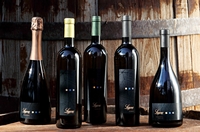I take pride in knowing Italian wines fairly well, but if you had asked me my feelings about Lugana until quite recently, I now realize that I likely would not have given the wine its due. With some recent exceptions, Italian white wines have a long history of undistinguished production, especially in northeastern and Central Italy. High crop levels of unremarkable grape varieties such as Trebbiano and unimaginative wine making techniques have produced floods of fresh, crisp, clean, fairly neutral white wines that are easily overshadowed by their red wine counterparts. Nothing to see here.
But the Lugana DOC district has been beating its drums over the past year, and a recent tasting of six Lugana wines finally opened my eyes. What I tasted were distinctive, flavorful whites with character.
Lugana is a small DOC district on the shores of Lake Garda, the huge lake that separates Italy’s Veneto region — famous for Bardolino, Valpolicella and Soave wines grown in the Lake Garda vicinity — from the region of Lombardy to its west. The Lugana zone is mainly in Lombardy but it straddles both regions, sitting squarely at the southern end of the lake, where it benefits from the lake’s moderating climate influence. Low morainic hills of ancient glacial formation to the district’s east, south and west hem in the

zone to form a natural distinctive terroir. The zone is rich in white clay, although the soil varies according to a vineyard’s proximity to the lake.
The grape of Lugana is Turbiana. Historically, this grape was called Trebbiano di Soave, but its name was later modified to Trebbiano di Lugana and then to Turbiana. The locals know with conviction that Turbiana is an “absolutely local” variety that’s distinct from Trebbiano di Soave. They note that Turbiana is part of the Trebbiano family of grapes, and that Trebbiano di Soave is its closest relative. Trebbiano di Soave in fact has been genetically identified as Verdicchio but the producers maintain that Turbiana is not Verdicchio.
The tasting I attended was sponsored by the Italian publication, Gambero Rosso, and moderated by Marco Sebellico, Editor-In-Chief of the Vini D'Italia Wine Guide. Six producers or their U.S. reps offered background on their own wines. Half the wines were from 2019 and two were Riserva, including a 2015 vintage. Very few white DOC wines in Italy provide for a Riserva category; for Lugana, the designation requires a minimum of two years aging.
The wines had many characteristics in common, and together they painted a clear image of the style of Lugana: dry, unoaked, medium-plus bodied, with high acidity which was not as salient a structural element as it is in many Italian whites because of wines’ contrasting broad, minerally texture; aromas of citrus, apple, almond, hazelnut, Mediterranean herbs such as lavender, some delicate floral notes, and wet stones. Sig. Sebellius named “minerality” as Lugana‘s signature characteristic. In fact, I would not place Lugana wines into my broad stylistic category of “fruity whites” nor that of “fresh, light, neutral whites” but instead would categorize them as “earthy whites” for their broadness and substance on the palate and their mineral tanginess.
The downside of finding so much commonality in the wines was that differentiating favorites or creating detailed descriptions of each seemed futile. Instead, I am naming the wines in the order of service, along with their prices (which are all estimates), and any particularity about their style or production. I rated them all between 90.5 and 92 points.
2019 Tommasi “Le Fornaci” Lugana, about $20, 12.5 percent alcohol, from three different parts of Lugana featuring clay soil near the lake, sand and loam elsewhere. Fresh, focused, with good concentration and a tangy finish, an overall well-balanced and satisfying wine.
2019 Pasini San Giovanni “Il Lugana,” about $21, 12.5 percent alcohol, from one organic vineyard on the Veneto side on white clay and another from the Lombardy side on “stony, boney morainic soil.” A few hours of skin contact brings out a pronounced fruitiness, but the wine still has broadness and minerality. Can age. A pre-release sample.
2019 Marangona, about $20, 12.5 percent alcohol, a composite of all the winery’s vineyards, from ten- to fifty-year-old vines on both clay and silt soils, biodynamically grown and produced. This wine struck me as the leanest, most vertical of the wines, with the most depth rather than broadness on the palate, fresh and energetic. It seems very young now.
2018 Cà Maiol, Molin, about $22, from a single vineyard with old vines on clay-dominant soil. Skin contact for 48 hours brings out softness and richness for a wine with lots of weight, character, and flavor complexity.
2018 Perla del Garda, Lugana Riserva, about $25, 13 percent alcohol, organically farmed, one of eight different Lugana wines produced by this winery, and reportedly less fruity than many of the others. One year lees aging in tank. Combines youthful delicacy with some richness of development and can benefit from bottle age.
2015 Corte Sermana “Sermana,” Lugana Riserva, about $20, 14 percent alcohol, from a warm vintage but poor chalky clay soils whose coldness delays the ripening process. Partially (ten percent) tonneaux-fermented. A rich wine that’s surprisingly fresh for its age, with citrus and herbal flavors abutting tertiary caramel, honey and dried-fruit notes. Days later, the portion of this wine remaining in my refrigerated bottle was still going strong.
To conclude the tasting, Andrea Bottari, Director of the Lugana Consorzio, commented, “The main advantage of Lugana wines is also their disadvantage: when young, they are straightforward, uncomplicated wines but in time, like a peacock’s tail, they can open up and surprise you.” If, that is…you don’t drink them up young.